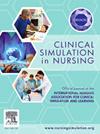A global survey of distress in simulation: Definition, frequency, and description
IF 2.5
3区 医学
Q1 NURSING
引用次数: 0
Abstract
Background
In healthcare, simulation-based education distress can impair cognitive performance and psychological well-being. However, its frequency and contributing factors remain underexplored.
Methods
To understand the frequency and occurrence of distress in simulation, a survey was distributed globally to simulationists, utilizing convenience and snowball sampling across global regions.
Results
The final sample included 143 participants from 27 countries. Distress was reported to occur occasionally (46.2%), with respondents witnessing a mean of 13.3 distress events during their career and 9.15 in their centre. A set of causes of distress was identified, distress was generally managed effectively, and no significant differences were found across accreditation status, years of experience, or global regions.
Conclusion
Distress occurs regularly, though is not a high-frequency event. Further systematic measurement can help to better understand the conditions and frequency of distress.
模拟中遇险的全球调查:定义、频率和描述
在医疗保健领域,基于模拟的教育痛苦会损害认知表现和心理健康。然而,其频率和影响因素仍未得到充分研究。方法为了了解模拟中遇险的发生频率和发生情况,利用便利和滚雪球抽样的方法,在全球范围内向模拟人员分发了一份调查。结果最终样本包括来自27个国家的143名参与者。据报告,偶尔会发生困扰(46.2%),受访者在其职业生涯中平均目睹13.3次困扰事件,在其中心平均目睹9.15次困扰事件。确定了一系列困扰的原因,困扰通常得到了有效的管理,并且在认证状态、多年经验或全球区域之间没有发现显着差异。结论焦虑有规律地发生,但不是高频事件。进一步的系统测量可以帮助更好地了解痛苦的情况和频率。
本文章由计算机程序翻译,如有差异,请以英文原文为准。
求助全文
约1分钟内获得全文
求助全文
来源期刊

Clinical Simulation in Nursing
NURSING-
CiteScore
5.50
自引率
15.40%
发文量
107
期刊介绍:
Clinical Simulation in Nursing is an international, peer reviewed journal published online monthly. Clinical Simulation in Nursing is the official journal of the International Nursing Association for Clinical Simulation & Learning (INACSL) and reflects its mission to advance the science of healthcare simulation.
We will review and accept articles from other health provider disciplines, if they are determined to be of interest to our readership. The journal accepts manuscripts meeting one or more of the following criteria:
Research articles and literature reviews (e.g. systematic, scoping, umbrella, integrative, etc.) about simulation
Innovative teaching/learning strategies using simulation
Articles updating guidelines, regulations, and legislative policies that impact simulation
Leadership for simulation
Simulation operations
Clinical and academic uses of simulation.
 求助内容:
求助内容: 应助结果提醒方式:
应助结果提醒方式:


